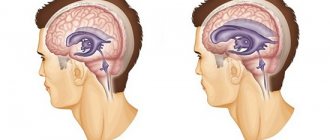An international team of specialists implemented a unique project on the Internet - MS Base, which made it possible to create an international database containing information about the medical histories of patients with multiple sclerosis.
To date, it has collected data on the course of the disease in more than 20,000 patients, residents of various countries and regions.
Disability scale
A disability scale for multiple sclerosis has been developed according to a simplified or expanded scheme. For the convenience of calculating scale points, neurologists use a special calculator that assesses the state of seven functional systems:
- Visual function.
- State of the brain stem.
- Pyramid system.
- Functions of the cerebellum.
- Sense organs.
- Assessment of pelvic organ function.
- Cognitive abilities.
In multiple sclerosis, the optic nerve is affected, leading to loss or partial impairment of vision.
The presence of a blind field of vision (scotoma) and visual acuity of both eyes are assessed. Symptoms from the cranial nerves, such as speech and swallowing disorders, give additional points. The state of the brain structure responsible for movement – the pyramidal system – is assessed. Signs of its damage: partial paralysis (tetraplegia, hemiplegia), muscle hypotonia.
The cerebellum is also affected in multiple sclerosis, which leads to impaired coordination of movements (). Points are awarded for these disorders. Sensory function also suffers: vibration, tactile, pain, and muscle-articular sensitivity may be impaired.
The functioning of internal organs is also assessed: symptoms such as urinary and fecal retention or incontinence. Intelligence assessment is also important for assigning a disability group. With MS, it can become disordered, even leading to the development of dementia.
Kurtzke scale 10-point:
- 1 point means that dysfunction of the nervous system is mild or absent;
- 2 points: disorders of gait, sensitivity and eye movement (nystagmus);
- 3 points: there is muscle weakness, paralysis of one of the limbs, lack of coordination;
- 4 points: the patient is capable of self-care, can stand for 12 hours, walk half a kilometer;
- 5 points: able to work for several hours a day, can walk a short distance without the help of other people;
- 6 points: capable of moving only with the help of other people over a distance of 20–100 m with one- or two-way support;
- 7 points: a wheelchair is required for movement, the ability for self-care and independent transfer to a wheelchair is preserved;
- 8 points: the activity of the upper extremities is preserved, but weakened, bed rest;
- 9 points: bed rest, needs assistance with eating, speech may be present or absent, swallowing may be impaired.
Conclusion
In case of multiple sclerosis, disability can be issued for a certain period or indefinitely. When receiving it, patients receive medications and benefits corresponding to the disability group. For questions related to receiving a disability subsidy, it is recommended to contact the All-Russian Public Organization of Disabled Persons with Multiple Sclerosis.
Multiple sclerosis is a terrible, dangerous pathology of the central nervous system. It often affects young people from 16 to 46 years old. A person with this diagnosis lives for at least a quarter of a century, but in the future he will face complete disability as the disease progresses. People with such a terrible diagnosis as sclerosis are supported by the state.
Patients with a diagnosis are assigned a disability and receive a subsidy from the state.
Conducting a medical examination with mandatory magnetic resonance imaging of the brain.
There is a relationship between the stage of severity and the course of the disease:
- At the first stage, symptoms of the affected nervous system are manifested, but its functioning is not impaired. The patient is fully able to work.
- In the second stage, visual and coordination functions of the nervous system and motor activity are not clearly expressed. The patient has a partial disability.
- In the third stage, persistent dysfunction of the NS is expressed. The person is partially incapacitated, which is expressed in the inability to concentrate, stand for a long time, or fully control the movements of his hands.
- When the patient has the fourth stage, dysfunction of vision and movement is acutely expressed. He cannot take care of himself; he constantly needs outside help. Here there is absolute unsuitability for any kind of work.
Based on the stages of severity of the pathology, we can conclude that a patient who has sclerosis of the first two stages of severity has limited fitness for this, that is, he can work, but not be very physically overloaded.
Labor Relations
In addition to the medical aspect of disability with MS, there is also an “urgent” one associated with obtaining income from work. In order not to lose their jobs, patients with multiple sclerosis can themselves refuse to be assigned a disability and not undergo VTEC
But if you do not take into account the work restrictions required even in the initial stages, you can significantly increase the risk of accelerating the development of the disease. For MS of any degree, it is better to refuse or at least strive to minimize:
- mental and physical overload;
- night work, irregular working hours, overtime;
- strong feelings, stress, anxiety;
- exposure to vibration;
- work involving contact with toxic substances;
- overheating and working in the sun.
The progression of MS imposes new restrictions, and at later stages the following are excluded:
- standing work;
- lifting weights;
- work with increased concentration and strong visual load;
- work associated with strict coordination and rhythm of movements.
Working conditions necessary for patients with multiple sclerosis (must be observed by both employer and employee):
- workplace in good transport accessibility from home;
- lack of responsibilities related to walking;
- favorable psychological climate in the team;
- presence of breaks in work;
- no overtime standards;
- sedentary work;
- calm mental work.
If these conditions are met, the patient will be able to remain able to work and work without further accelerating the course of MS.
Patients should also remember about the state’s social guarantees for people with disabilities, and also use them, instead of hiding the diagnosis and denying the existing state of affairs. Let us remind you that according to the laws of the Russian Federation, any employer must:
- determine a quota of jobs for people with disabilities;
- hire a disabled person if his health condition corresponds to his job duties and working conditions, even if the quota is exceeded;
- exclude dismissal due to disability.
Violations of these clauses are appealed in court. As for the employee, compliance with the restrictions dictated by multiple sclerosis allows him to remain productive for a long time, and the assignment of disability when MS reaches serious stages provides social support and a disability pension.
Disability
Young patients with multiple sclerosis become incapacitated in 30% of cases within the first 2 years.
Obtaining disability is possible after examination by neurologists of the Medical Labor Expert Commission (VTEK). They have the right, based on the diagnosis, to assign a disability to the patient and record its category. The patient is examined (depending on the ability to move) in a hospital or at home. The duration of the award is usually 1 year.
The chief or attending physician of the hospital to which the patient is assigned will help you obtain a referral.
Disabled groups are assigned depending on:
- general condition of the patient;
- stages of visual impairment;
- deviations from the norms of motor function;
- self-service options;
- degree of nervous system dysfunction.
Among other things, some indicators can add points to the group identification scale: analysis of the general structure of the brain, possible swallowing disorders, speech problems.
Attention is also paid to the work of internal organs and the involuntary processes of bowel movements and urination. In addition, with regular re-examination of the patient’s condition, if this condition worsens, a different degree of disability may be assigned
And if improvement occurs and, moreover, the patient becomes able to work, deprivation of the disabled group occurs
In addition, with regular re-examination of the patient’s condition, if this condition worsens, a different degree of disability may be assigned. And if there is an improvement and, moreover, the patient becomes able to work, deprivation of the disabled group occurs.
There are 3 disability groups:
- (III) The third degree is characterized by social difficulties in interaction and progressive deterioration of body functions.
- (II) The second is awarded in case of extensive motor dysfunctions and limitation of life activities.
- (I) The first is given to patients with severe musculoskeletal disorders, paralysis, impaired vision, and inability to navigate and care for themselves.
Assigning a degree of disability without the right to re-examine is possible if doctors note the impossibility of overcoming social disability.
Due to loss of legal capacity and certified disability, a need arises to receive financial assistance.
Is there a disability?
If signals of multiple sclerosis have been identified and an appropriate diagnosis has been made, the citizen has every right to apply for the status of a disabled person.
To do this, he will need to undergo a full medical examination carried out by expert doctors - a medical and social examination.
Based on the results of the examination, an appropriate decision will be made on assigning a certain disability group, as well as its duration. At the same time, it will be necessary to periodically undergo re-examination in order to assign a different group if the state of health worsens, and if it improves, to lose the status of a disabled person.
FAQ
People who have encountered this disease themselves or observe its progression in a member of their family are wondering how to live on.
Can a person with MS study or work?
Due to the fact that MS is not characterized by a general manifestation, severity and frequency of occurrence, it is difficult to answer this question unambiguously. The ability to perform job duties or attend classes is affected by the degree of disability.
Therapeutic exercises for multiple sclerosis
If a person has group 3 disability, he can continue to lead the lifestyle to which he is accustomed.
During remission, the patient must assess the level of his capabilities in a specific industry:
- physical;
- social;
- cognitive abilities.
This will allow you to move towards the goal not only at this stage, but also in the future.
Should you talk about your illness to your family and friends?
The patient has every right to decide for himself whether to hide the discovered illness or tell his loved ones.
If there are no visible signs, then you don’t have to rush to inform your family.
But when you discover the secret, you will be able to take advantage of the benefits provided. For example, in educational institutions such patients are trained under special programs, can count on individual exams, etc.
How to live further after diagnosis?
If the disease is detected early, treatment will be more effective. It is necessary to take beta interferons, which will help slow down the process of disability and reduce the severity and frequency of exacerbations.
The patient should adapt to the disability (if it is not very pronounced) and continue to live his previous life.
There is no general treatment method. If a serious exacerbation is observed, the doctor will prescribe corticosteroids, methylprednisolone intravenously, with a further transition to prednisolone.
The severity and severity of exacerbation is reduced with certain drugs that were approved for use only recently:
Betaferon and betaseron.
The patient must undergo rehabilitation after an exacerbation.
In case of remissions, maintenance therapy is prescribed, as well as:
- physical exercise (stretching and coordination);
- speech therapy classes;
- physiotherapy.
Which specialists should I contact?
How to live without exacerbations or reduce them to a minimum? It is worth seeing specialists. Multiple sclerosis is the responsibility of a neurologist. Your family doctor will help you and your loved ones learn all the nuances about the course of the disease.
Many also turn to medical institutions for psychological support.
For specific problems that may arise due to the disease, contact:
Will volunteers help if I'm lonely?
Single people can count on support from social assistance workers in managing their household.
There are volunteer movements in the country that will support and help in solving problems.
Such organizations have special literature on multiple sclerosis, which is provided to patients free of charge. You can find the trust numbers and address of such a company on the RS International Portal.
Does MS in older people differ from the disease in young people and children?
MS can debut in a person of any age, but is most often diagnosed in people 25–35 years old, with females being at greater risk. In old age, as in young people, the disease rarely appears.
The course of multiple sclerosis in a two-year-old child is mild, and complications are minimal.
In young people and children (as opposed to older patients), the disease is accompanied by:
The remaining symptoms are general. According to research, if a child gets sick before the age of 16, the course of the disease will be more favorable. But there are cases when, after 20–30 years, such people experience significant disability.
The disability group for MS is established
With moderate functional impairments, expressed in dysfunctions of the musculoskeletal system, vision, and speech, a moderate degree of the disease can be established. In this case, the person remains able to work, but the list of possible professions is limited: the patient needs a job that does not involve physical exertion or movement. This results in moderate restrictions (grade 1). In such cases, disability group 3 is usually established.
If a sick person has paralysis of both limbs (lower or upper), severe coordination disorder, significant deterioration of visual functions, active spread of the disease, then restrictions on movement and independent care are of the second degree - pronounced restrictions. In this case, a person can move only with the help of additional devices. Or with the help of strangers.
This development of the disease gives grounds for the appointment of the 2nd disability group.
If the clinical and rehabilitation prognosis is negative, then the ineffectiveness of restorative procedures is determined. This provides grounds for establishing permanent disability without the need for periodic examination.
If the clinical and rehabilitation prognosis is unfavorable, the rehabilitation measures are ineffective, the disability group is established without a period for re-examination (indefinitely).
After examining the patient by a commission of neurologists, it can make a decision to assign him a disability of a certain group, but usually for a period of no more than one year. Sometimes this decision lasts for several years in a row. If the group is issued for a year, then after 12 months you will have to visit a similar commission again.
Depending on whether the disease progresses or declines, the disability group may be changed
When examining a patient, attention is paid to such important criteria as:
- Is a patient with multiple sclerosis capable of caring for himself?
- Does he have any vision problems?
- How seriously does his nervous system suffer from the disease?
There can be three groups in total, one of which you can count on:
- The first group includes patients who have serious vision problems, and also have disorders in the functioning of the musculoskeletal system, usually in the form of local paralysis
- The second group is assigned to those who have noticeable motor dysfunction and other accompanying disorders
- The third group includes those patients who are almost fully functional, but have innervation disorders
Depending on the degree of disability assigned to the patient, he will receive appropriate government payments for this.
Their sizes are as follows:
- 1 group – 9,919 rubles
- Group 2 – 4,959 rubles
- Group 3 – 4,215 rubles
- Group 4 (concerning children with disabilities) – 11,903 rubles
Migraine: what you need to know when communicating with the military registration and enlistment office and how to prove the diagnosis
During the period of remission, signs of migraine do not appear, the person looks completely healthy, so it will not be possible to prove the existing diagnosis to doctors at the military registration and enlistment office during a visual examination.
In this case, the basis for issuing a conclusion about the unsuitability of military service is an outpatient card with relevant records of treatment at least 2 times a year and a conclusion from a neurologist confirming the diagnosis.
With the onset of conscription age, the young man is sent to the hospital to undergo diagnostics and determine the degree of complexity of the disease. To make a diagnosis of migraine, he needs to undergo the following types of research:
- Brain MRI;
- Doppler ultrasound of cerebral vessels;
- Electroencephalogram;
- Computed tomography;
- Clinical blood tests.
How to apply for and receive disabled status?
Only neurologists who are members of the expert commission (IEC) can legally assign disability for multiple sclerosis, and only after the patient has undergone a special full examination.
The attending physician at the place of residence should refer you for such an examination . In this case, the commission can be carried out both in a medical institution (if the patient is able to move) and at home (with bed rest).
When undergoing such an examination, you will need to prepare the following documents and their photocopies:
- identification document;
- referral for examination (form 0-88/у);
- medical documents confirming the presence of the disease (outpatient card, conclusions of highly specialized specialists, photographs, etc.);
- work book (if available);
- ITU certificate (during re-examination).
As a result of the examination, the patient is assigned a certain degree of disability for a period of usually one year.
Then, at certain intervals (usually once a year), this disability group will need to be confirmed or a new one issued if your health worsens. Also, such a person must receive social benefits established by law.
What is the EDSS scale?
In such medical practice, in order to establish one or another degree of disability in patients with this kind of diagnosis, the popular special EDSS scale is used, which is based on a point assessment of the functioning of the basic human systems. It was proposed in 1983 by the American epidemiologist John Kurtzke.
Methodology for assessing the disease
A neurologist examines the patient, during which his functional systems are examined, such as the ability to think, visual impairment, pyramidal system, pelvic organs, some parts of the brain - the cerebellum, sensory and brainstem.
For each such studied area of the human body, a corresponding score is given, which are subsequently summed up on a calculator and presented as a certain score.
Depending on this score on a developed scale, the degree of disability is determined.
How are the results interpreted?
Considering the obtained values, the following results can be obtained:
| Point | Decoding |
| the patient is healthy, there are no neurological problems | |
| 1 | disability is not expressed, but there are deviations in the operation of one of the systems under study |
| 1,5 | no disability is noted, but deviations were found in the operation of at least two of the functional systems |
| 2 | disability is minimal, but does not cause significant inconvenience in life |
| 2,5 | there is “mild” disability in 1 system / minimal deviations in several parts of the brain |
| 3 | moderate disability is manifested / minimal changes in 3-4 studied systems, while the patient continues therapy on a non-inpatient basis |
| 3,5 | signs of disability are progressing, but therapy is not inpatient |
| 4 | receiving outpatient treatment with an active day life, the ability to independently overcome 0.5 km |
| 4,5 | receiving non-inpatient treatment with active daily life during the day, the ability to travel 0.3 km without anyone else |
| 5 | decreased quality of life, the ability to independently overcome 0.2 km, a reduction in working time is necessary |
| 5,5 | decreased quality of life, the ability to independently overcome up to 0.1 km, a reduction in working time is necessary |
| 6 | walking less than 0.1 km requires the use of a cane or any other support |
| 6,5 | to overcome short distances (up to 0.02 km), the use of crutches/walkers is necessary |
| 7 | movement is almost impossible (no more than 5 meters) even with additional supports |
| 7,5 | Requires assistance to move in a wheelchair |
| 8 | bed rest with no mobility, with the possibility of self-care |
| 8,5 | Complete bed rest without self-care |
| 9 | bed stay and communication skills |
| 9,5 | complete inability to demonstrate human skills (speaking, swallowing, etc.) |
| 10 | death due to disease progression |
What disability group is given?
So, let’s figure out which group of disabilities is assigned to multiple sclerosis.
In accordance with the points scored during the examination, the doctor determines the corresponding disability group on the EDSS scale. According to it, the patient is assigned:
- Group 3 – with an amount of 3-4.5 b.;
- Group 2 – with an amount of 5-7 b.;
- Group 1 – with an amount of 7.5-9.5 b.
Special EDSS calculator
Experts have developed a special EDSS calculator for multiple sclerosis, which has universal access on the Internet . It makes this type of assessment of patients diagnosed with multiple sclerosis much easier.
At the same time, you should not assign a disability yourself, since this should only be done by a qualified neurologist.
For each functional system, the doctor must select its condition and the presence/absence of any abnormalities. After filling in all the fields, the calculator will display the result on the EDSS scale.
Read about treatment standards and lifestyle for multiple sclerosis:
- what is an exacerbation of the disease, how and why it manifests itself;
- what should the diet be like for MS, what vitamins does the patient need;
- Is it possible to treat the disease with folk remedies, as well as with a bone marrow transplant;
- what is the importance of physical therapy for this disease.
Interpretation of results
EDSS scale (clickable)
Functional systems are assessed for each parameter separately. If all subsections receive 0 points, then there are no changes. Visual function is assessed from 0 to 6 points, brainstem functions - up to 5 points, pyramidal - up to 6, cerebellar - up to 5, sensory - up to 6, pelvic organs - up to 6, intellectual function - up to 5.
When determining damage to the optic nerve, the assessment is made in the worse eye. Before this, the patient is examined by an ophthalmologist: he determines visual acuity and fields, and checks the fundus.
Signs of damage to the pyramidal tract are determined by the most affected limb. If the patient complains about something, but there are no visible changes, one point is assigned. When assessing sensitivity, pain, temperature and one's own sensations are taken into account. Vibration sensitivity is determined using a tuning fork. Subjective complaints of patients about a burning sensation and tingling sensation in the extremities are not taken into account.
When analyzing intellectual function, depressive and euphoric manifestations are assigned 1 point.
The presented system analysis creates the basis for determining the degree of disability of a person. Next, the doctor moves on to the expanded EDSS scale, taking into account previously identified disorders. The EDSS system is also used in multiple sclerosis to understand whether the treatment is having a positive effect or not.
The fundamental indicator of the expanded scale is the patient’s ability to move independently. If he can walk half a kilometer or more without assistance, the values for all functional systems are added up
If a person is able to walk up to five hundred meters on his own, the main attention switches to the walking function (4.5 points on the extended scale or more). The degree of disability according to the EDSS of less than four points corresponds to people who walk independently over five hundred meters, while the exact degree is confirmed by points of the FS system
Grades between four and five points are determined by both the distance traveled and the level of functional impairment. The basic rule when calculating is that the score is determined by the lesser of these two parameters.
Grades from 5.5 to 8 points are characterized only by the distance traveled, the use of a wheelchair or the assistance of others.
The result of the extended EDSS scale should not be less than any of the functional system indicators (with the exception of visual function and pelvic organ function).
Grades 6-6.5 include both additional support and distance traveled. If a person walks over one hundred meters on crutches or with two canes, he is assigned stage 6. If he walks with the specified devices over ten meters, but not more than one hundred, disability is assessed at 6.5 points.
So, we can say that the extended scale is a kind of continuation of the FS model. This is the so-called “scale within a scale”. Without a preliminary analysis of functional systems, it is not possible to establish the degree of disability.
The lowest EDSS score (0 points) means the absence of neurological symptoms. Patients who score 1-4.5 points are able to fully care for themselves. A score of 7 points or higher indicates a person’s deep disability.
Disability group
The EDSS scale allows you to assign one or another degree of disability for multiple sclerosis:
- 3-4.5 points – third group;
- 5-7 points – second;
- 7.5-9.5 – first.
The network provides online EDSS calculators that allow you to get tested if you suspect you have multiple sclerosis.
Regular and extended scales
The FS model is designed to determine the state of the body's conducting systems and includes seven subsections.
Each of them is presented in the form of a point gradation of violations of a certain system according to the severity of the disorder. The sum of points for each scale is calculated separately. The use of the system provides an in-depth understanding of the stage of the disease and allows for constant monitoring of the course of the pathological process.
The expanded EDSS scale is used to determine the degree of disability. This is the most common system for tracking disease progression. The calculation determines the walking index, indicating the patient’s ability to walk a distance of up to 500 meters without anyone’s help, up to 100 meters with an assistant, etc.
The scale of the state of functional systems combines groups of symptoms:
- damage to the optic nerve;
- disorders of the cranial nerves (except for the second pair);
- signs of damage to the pyramidal tract;
- coordination disorders;
- sensitivity disorders;
- pelvic organ dysfunction;
- intellectual disorders.
The system for assessing the degree of disability includes the following parameters:
- presence of minimal symptoms;
- slight weakness, minor gait disturbances;
- moderate weakness, unsteadiness of gait, weakening of voluntary movements;
- complete self-care, relative weakness, ability to stay upright for up to half a day;
- independent movement over short distances, shortened working hours;
- moving only with support;
- independent movement in a wheelchair, the patient can sit in it himself;
- restriction of movement to a bed or wheelchair, self-care with hands;
- complete helplessness, the patient is chained to the bed.
Prognosis and life expectancy for multiple sclerosis
You can see a person with such a disease on the street only if motor functions are intact. But more often, multiple sclerosis is recognized only by those who have had this problem in their family.
Multiple sclerosis is a chronic disease that leads to disability. With it, people rarely live to old age, especially in cases where there is a remitting form and constant treatment.
The main cause of death is the presence of infection or bulbar disorders (problematic swallowing, chewing, etc.).
- All information on the site is for informational purposes only and is NOT a guide to action!
- Only a DOCTOR can give you an ACCURATE DIAGNOSIS!
- We kindly ask you NOT to self-medicate, but to make an appointment with a specialist!
- Health to you and your loved ones!
Do they take you into the army?
Since multiple sclerosis is an incurable disease and tends to progress, it is considered dangerous for the armed forces.
Also, no specialist will be able to predict when exactly the disease will begin to progress sharply.
If such a diagnosis has been made, when passing the draft board, young people will be recognized as unfit for service - category D.
It is important to know that an incurable disease like multiple sclerosis is very serious and requires timely diagnosis. Also, people suffering from it can count on registration of a certain disability group, which is assigned after a special examination conducted by ITU.









